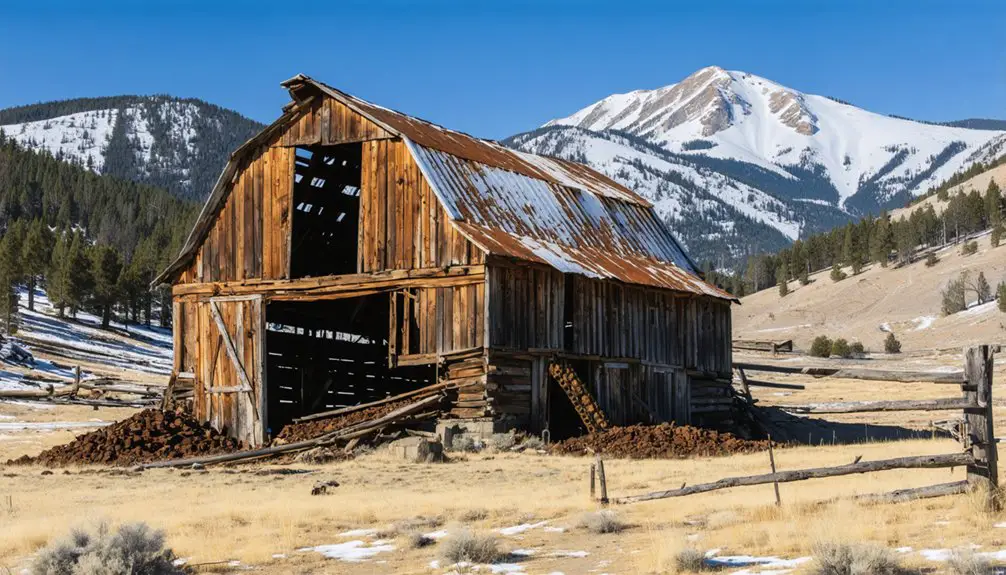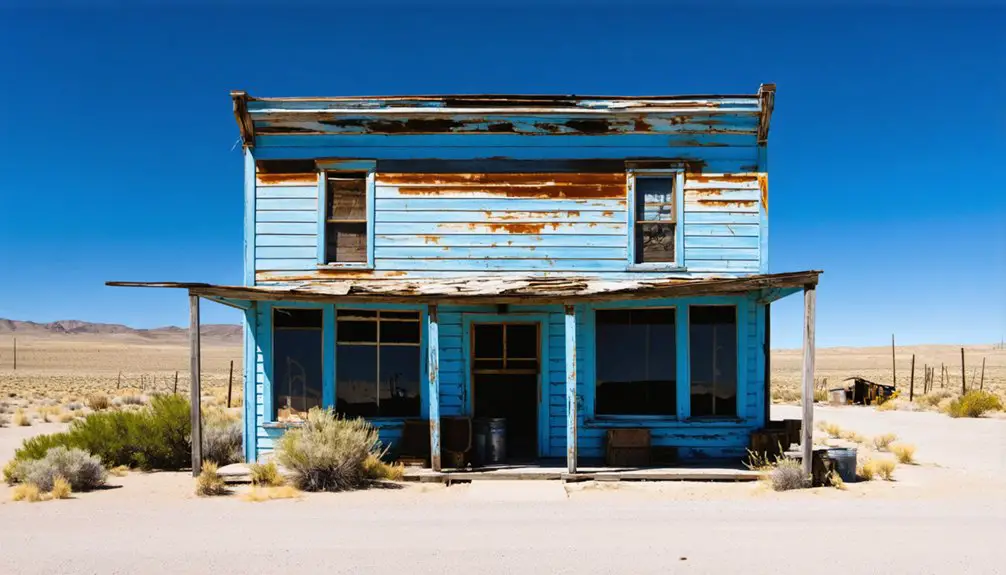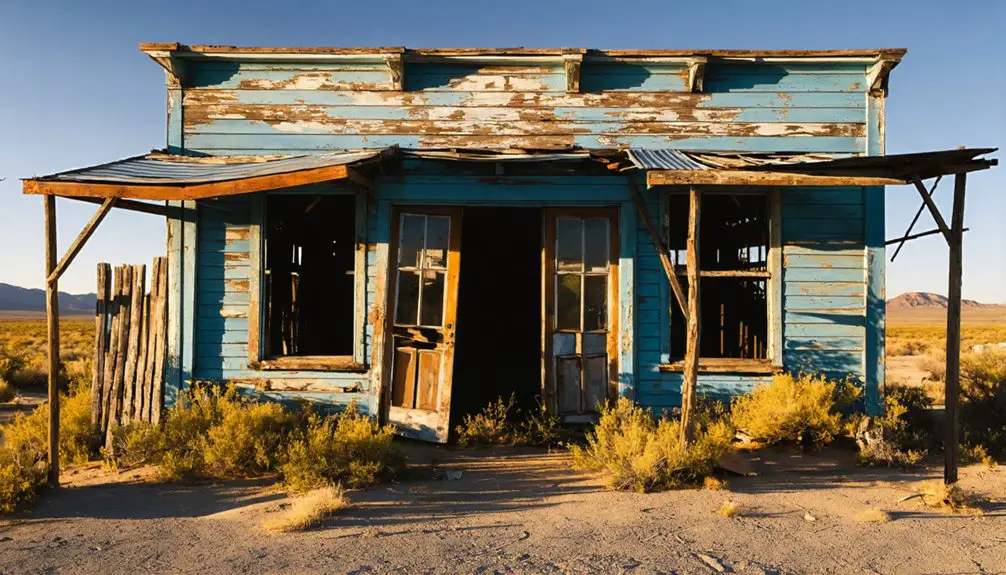You won’t find a ghost town in Paisley, Oregon, but rather a thriving frontier community of 250 residents in Lake County’s high desert. Since its 1873 founding, this resilient town has adapted from its logging and ranching roots while preserving landmarks like Oregon’s oldest bar, the Pioneer Saloon. Today, you’ll discover a close-knit community celebrating its heritage through annual traditions like the Mosquito Festival. There’s more to this small town’s story than first meets the eye.
Key Takeaways
- Paisley is not a ghost town, maintaining an active population of approximately 250 residents with ongoing community events and traditions.
- The town experienced economic changes after its lumber mill closed in 1980 but adapted through ranching and tourism.
- Historic structures like the Pioneer Saloon, Oregon’s oldest bar, remain operational and preserved, indicating continued community vitality.
- Annual events like the Mosquito Festival demonstrate an active, engaged community rather than abandoned settlement characteristics.
- The town sustains itself through ranching, tourism, and outdoor recreation, with close-knit community networks and functioning local businesses.
Native Roots in the Chewaucan Valley
Before the town of Paisley emerged in Oregon’s Chewaucan Valley, the Northern Paiute people maintained deep ancestral ties to this land, with their territory encompassing the Chewaucan Basin and surrounding features like Abert Rim and Tucker Hill.
You’ll find evidence of their cultural heritage in the Paisley Caves, where some of North America’s oldest human DNA has been discovered. The tribes adapted their practices by shifting to root processing after large mammal populations declined.
The Northern Paiute, including the Burns Paiute and members of the Klamath Tribes, practiced seasonal migration throughout the region, following food and water sources. Their indigenous practices centered on harvesting wapato (chewa) from the marshlands and hunting with specialized bird points – delicate arrowheads effective for both waterfowl and larger game. The Chewaucan Marsh and River provided essential resources for their seasonal settlements.
Northern Paiute hunters followed seasonal patterns, gathering wapato roots and using finely crafted arrowheads to take both birds and big game.
Today, these sacred landscapes remain spiritually significant to tribal members who continue their traditional connections to the Chewaucan Basin.
From Frontier Settlement to Modern Times
When enterprising settlers established Paisley in 1873, they laid the foundation for Lake County’s enduring frontier outpost along the Chewaucan River.
You’ll find evidence of frontier challenges in the bullet-riddled post office building, a reflection of an early 1900s robbery attempt that failed.
The town’s economic changes mirror the story of many Western communities. From its logging and ranching roots, Paisley grew steadily to 257 residents by 1920. Like many frontier mining camps, the town faced economic ups and downs as industries evolved. Oregon’s history includes over 200 ghost towns that faced similar economic challenges.
When the lumber mill closed around 1980, the community adapted but didn’t falter. Today, you’ll discover a resilient town of about 250 people, where the K-12 school continues to anchor the community.
While the timber industry’s gone, Paisley’s maintained its identity through ranching, tourism, and outdoor recreation in the surrounding national forests.
Natural Wonders and Geographic Features
You’ll find yourself surrounded by sweeping high desert terrain when you visit Paisley, where the Christmas Valley sand dunes stretch across the landscape to the east.
The Chewaucan River cuts through this semi-arid region, creating an essential water source amid volcanic formations and scattered hills characteristic of eastern Oregon’s geological history. The close-knit community members share traditions and stories while navigating the harsh beauty of their environment.
The area’s natural features include rugged lava fields shaped by ancient volcanic activity, while the surrounding plains support native grasses and drought-resistant vegetation adapted to the challenging climate. The region experiences heavy snowfall during winter months, creating dramatic seasonal transformations in the landscape.
Hot Springs Paradise
At the southern end of Summer Lake in south-central Oregon lies Summer Lake Hot Springs, a natural wonder featuring four artesian mineral springs that flow at 123°F (51°C).
You’ll find these therapeutic waters emerging from underground aquifers, rich in silica that gives the water its signature silky texture. The springs pump out about 20 gallons per minute, feeding several soaking pools including one housed in a historic century-old barn.
You’re surrounded by 20,000 acres of raw high desert landscape, where fault scarps and geological formations create dramatic panoramic views. The valley enjoys mild desert temperatures ranging from 80-90°F in summer.
While you soak in the mineral benefits, you’ll have front-row access to the Summer Lake Wildlife Area, Oregon’s first bird sanctuary.
After sunset, you can marvel at pristine night skies in one of the world’s largest Dark Sky Sanctuaries.
The resort offers twelve rental lodges with geothermally heated floors for year-round comfort.
High Desert Terrain Features
The rugged Oregon high desert sprawls across 24,000 square miles of central and southeastern Oregon, dominated by volcanic formations and dramatic fault-block mountains.
You’ll find yourself surrounded by ancient basalt flows and towering escarpments that tell a story of massive geological forces at work.
The region was shaped by significant volcanic activity that occurred 15 to 17 million years ago, creating vast lava flows and rugged terrain.
The landscape receives sparse precipitation, with most areas getting less than 15 inches of annual rainfall.
As you explore this stark landscape, you’ll encounter imposing fault block mountains like Steens Mountain, which rises to 9,733 feet, and the Warner Mountains, created by crustal extension over millions of years.
Between these giants lie broad closed basins, including the Alvord Desert and Catlow Valley, where alkali lakes and playa surfaces stretch toward the horizon.
The terrain varies from rolling volcanic uplands to deep river canyons, all shaped by the rain shadow of the distant Cascade Range.
The Spirit of Small-Town Living
You’ll find Paisley’s small-town character alive in its close-knit population of 250 residents, where households maintain strong social connections despite being widely dispersed throughout the rural landscape.
The town’s signature Mosquito Festival in July brings the community together for a cherished annual tradition that reflects the enduring social fabric of this remote Oregon settlement.
Within Paisley’s demographic makeup, where 97% of residents identify as White and the median age hovers around 26 years, families and individuals forge meaningful relationships that help preserve the town’s dynamism despite its economic challenges.
Tight-Knit Community Bonds
Living in Paisley means experiencing genuine small-town bonds, where a population of just 271 residents fosters extraordinarily close relationships.
You’ll find a tightly woven social fabric where nearly half the households are families, and homeowners make up 46.7% of residents, creating lasting neighborhood connections.
Community gatherings thrive among the mainly white population, where shared cultural understanding enables smooth communication and strong traditions.
The town’s modest median income of around $61,667 encourages neighborly support, with residents helping each other through economic challenges.
Multi-generational families and elderly neighbors living alone (20%) create natural caregiving networks.
While many commute outside town for work, the shared experience of small-town life keeps Paisley’s community spirit alive through mutual dependence and cooperation.
Annual Traditions Unite Residents
Since 1984, Paisley’s signature Mosquito Festival has drawn thousands of visitors to this tiny Oregon hamlet during the last weekend of July.
What started as a fundraiser for mosquito control by residents Larry and Bev Hill has evolved into one of the region’s most distinctive community events.
You’ll find these local traditions still bringing people together:
- A lively rodeo and parade that transforms the quiet streets
- Community-wide BBQ and pancake breakfast celebrations
- Historic “Ms. Quito” pageant competitions from earlier years
- Crucial fundraising for vector control equipment
While vendor participation has declined recently, the festival remains essential to Paisley’s identity.
It’s where generations connect, stories are shared, and the town’s unique character shines through – proving that even the pesky mosquito problem can unite a community in creative ways.
Ranching and Logging Legacy

When M.M. Gillespie introduced cattle to Paisley in 1871, he launched a ranching history that would shape the region for generations.
You’ll find that the Chewaucan River’s irrigation systems and abundant aquifers gave local ranchers an edge over their dryland farming counterparts elsewhere in Oregon.
The logging impact quickly followed, with timber operations springing up on nearby mountain ridges.
You’ll discover how these twin industries supported each other – ranchers used logging paths while timber workers’ families sustained the local economy.
Until 1980, the lumber mill served as an essential employer, though logging hasn’t completely vanished from the area.
Today, while Paisley’s population hovers around 200, you can still spot ranching operations and witness the old mill standing as a monument to the town’s resourceful past.
Preserving the Past While Moving Forward
Paisley’s commitment to historic preservation shines through its landmark Pioneer Saloon, standing proudly as Oregon’s oldest bar for over 140 years.
You’ll find its original East Coast furniture still intact, serving as a proof of meticulous preservation efforts that define this frontier town’s character.
Modern-day Paisley balances community heritage with practical needs through:
- Careful integration of modern amenities while maintaining historical aesthetics
- Strategic adaptive reuse of buildings for museums and shops
- Protection of architectural elements through local preservation guidelines
- Heritage tourism initiatives that fund ongoing preservation work
The town’s approach guarantees its historic structures remain vibrant community assets while supporting economic growth.
From the Pioneer Saloon to nearby archaeological sites like Paisley Caves, you’re witnessing living history that continues to shape the town’s identity.
Year-Round Adventures and Attractions

Although nestled in Oregon’s high desert, Paisley offers adventures across all four seasons.
You’ll find year-round outdoor activities along the Oregon Desert Trail, from hiking and mountain biking to wildlife watching at ZX Ranch. When snow blankets the higher elevations, you can switch to snowshoeing and cross-country skiing.
The town’s cultural experiences remain accessible throughout the year. Visit the historic Coats Observatory for stargazing, or explore the Paisley Museum’s Native American artifacts.
The Pioneer Saloon serves meals year-round, while seasonal farmers’ markets showcase local crafts and produce. You can join guided tours of archaeological sites, attend astronomy nights, or participate in cultural workshops led by local historians.
During summer months, outdoor music events and autumn harvest festivals add extra vibrancy to this desert community.
Frequently Asked Questions
Are There Any Haunted Buildings or Ghost Stories in Paisley?
You’ll discover spine-tingling ghost sightings at Fiddler’s Green, Blackburn Manor, Linkville Playhouse, Baldwin Hotel Museum, and Wheel Cafe. Local legends surround these historic buildings, with shadowy figures and mysterious noises reported regularly.
What Happened to Paisley’s Original Native American Inhabitants?
You’ll find the Native American inhabitants faced displacement from their ancestral lands when ranchers and loggers arrived in 1871, forcing them to abandon their traditional wapato harvesting and seasonal settlements around Chewaucan Marsh.
Can Visitors Stay Overnight in Paisley, and Where?
You’ll find overnight accommodations at Paisley Sage Rooms motel, offering four well-equipped rooms from $95/night. While nearby Summer Lake Hot Springs provides alternative lodging, camping options exist in surrounding national forest areas.
How Safe Is Paisley for Tourists Exploring Abandoned Structures?
You’ll need to follow basic tourist guidelines and safety precautions: avoid unstable structures, bring emergency supplies, and don’t explore alone. Crime rates vary, but isolation poses bigger risks than crime.
What’s the Best Time of Year to Visit the Paisley Area?
You’ll find the best season to visit is July through September, when weather conditions are dry and warm, with temperatures around 63°F and minimal rain to interrupt your outdoor exploration.
References
- https://www.hmdb.org/m.asp?m=113765
- https://kids.kiddle.co/List_of_ghost_towns_in_Oregon
- https://en.wikipedia.org/wiki/List_of_ghost_towns_in_Oregon
- https://www.tripadvisor.com/ShowTopic-g51941-i3963-k2083716-Paisley_Oregon_Is_it_close_By_Lakeview_Oregon-Lakeview_Oregon.html
- https://www.thetravel.com/most-obscure-towns-in-oregon/
- http://oregonconsensus.org/wp-content/uploads/2024/07/Lake-Abert-and-Chewaucan-Basin-Assessment_formatted_FINAL_02-13-23.pdf
- http://oregonconsensus.org/wp-content/uploads/2024/07/JFF-DRAFT-12_-Chewaucan-Abert-Joint-Narrative-Outline.pdf
- https://www.notesfromtheroad.com/greatbasin/alvord-desert.html
- https://www.notesfromtheroad.com/greatbasin/lake-chewaucan.html
- https://www.wikiwand.com/en/articles/List_of_ghost_towns_in_Oregon



